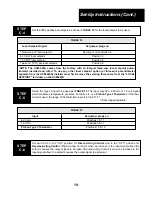
Throttling Range
Switch A6
Switch A7
Switch A8
10%
OFF
OFF
OFF
20%
OFF
OFF
ON
35%
OFF
ON
OFF
50%
OFF
ON
ON
65%
ON
OFF
OFF
80%
ON
OFF
ON
90%
ON
ON
OFF
100%
ON
ON
ON
Input
Set jumper plugs on
4-20 mA
Positions 7 and 11
1-5 VDC
Positions 8 and 11
PreCon Type 3 Thermistor
Positions 10 and 12
14
Select the type of input to be used and set the jumper per TABLE 3. The input may be a 4-20 mA
or 1-5 volt signal that measures temperature, pressure, humidity, etc., or a PreCon Type 3
Thermistor. If the thermistor is used, the range of the thermistor is 50° to 90°F.*
*Other ranges available
STEP
A-3
TABLE 3
TABLE 4
Set switch A3 in the "ON" position for Direct-Acting Control and in the "OFF" position for
Reverse-Acting Control. (
Direct-Acting Control
is when an increase in the input signal above set-
point causes the output signal to increase.
Reverse-Acting Control
is when an increase in the input
signal above setpoint causes the output signal to decrease.)
STEP
A-4
Set the proportional throttling range per TABLE 4. The throttling range is the amount of signal
change at the input required to cause the output signal to go through its entire range (4-20 mA).
For example, a 20% throttling range means that a 1 mA change in the input causes a 5 mA change
in the output signal. When using the optional thermistor input, a 1°F change in input is the equiva-
lent of 0.4 mA change in the mA input mode. The correct throttling range cannot be calculated, but
must be adjusted for each application. Generally, systems that respond quickly should have a nar-
rower throttling range than systems that respond slowly.
STEP
A-5
Set-Up Instructions (Cont.)
















































